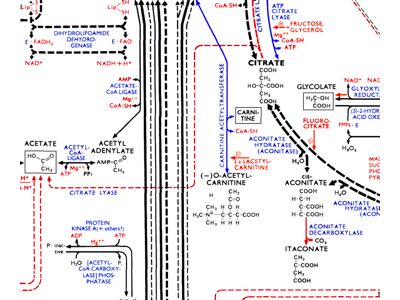
This is tile F6 (zoom in to F6 for the source). There’s citrate there. You can see ATP, which carries energy around the body, in a few places.
This is what I love about the cycle: It’s a closed cycle. It’s the engine of life. Every ecosystem must complete this cycle to keep going. When we look at animals and plants, we start thinking things like “oh, they have to eat something” and “they turn that into muscle and energy” so we have input and outputs. But here, it’s self-complete. There is no input but sunlight. It eats and transforms itself. It’s just an instantiation of Conway’s Game of Life turning over and over. (I wax lyrical about the metabolic cycle.)
It’s like the combustion engine: Sunlight (or petrol) in, everything else out. Life eats life. It just perpetuates. And each step of the cycle – between the bodies of life – is mediated by a chemical.
And citrate, that’s lemons, right. The Krebs cycle, this fossil of metabolism, is also called the citric acid cycle because it’s mediated by that chemical. When you taste a lemon, you’re looking end-on at the very centre of the ecosystem. You looking end on at the total interconnectedness of present-day life on Earth.
Plus the pure aesthetic of the diagram is just perfect. It looks like Garland/Chapman’s Connect game. It looks like Clapham Junction.